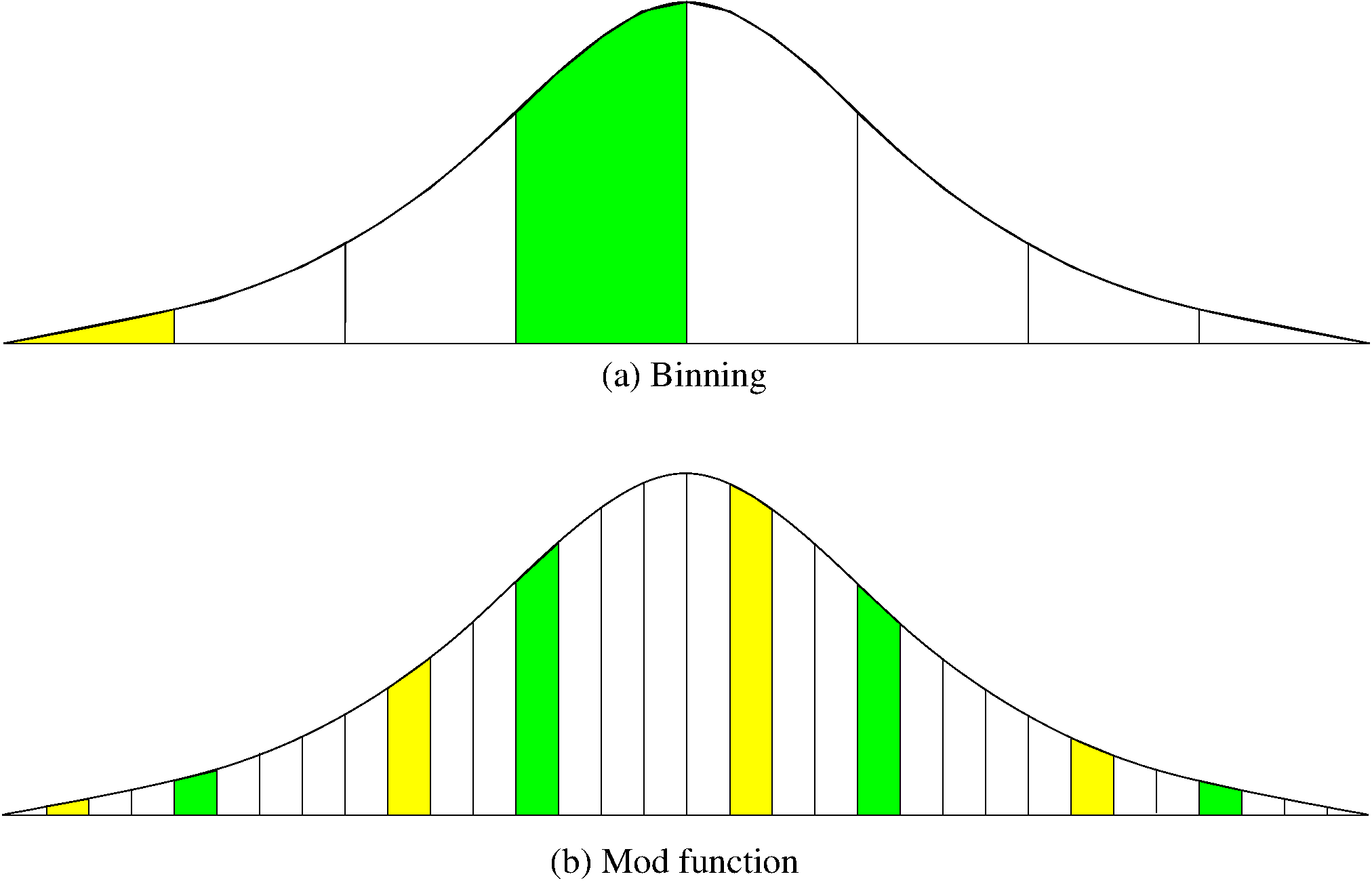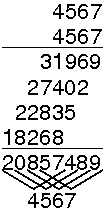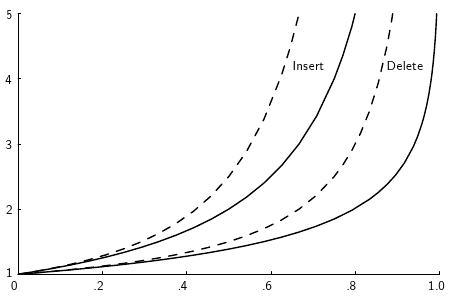17.10. Hashing¶
17.10.1. Hashing¶
17.10.1.1. Hashing (1)¶
Hashing: The process of mapping a key value to a position in a table.
A hash function maps key values to positions. It is denoted by h.
A hash table is an array that holds the records. It is denoted by HT.
HT has M slots, indexed form 0 to M−1.
17.10.1.2. Hashing (2)¶
For any value K in the key range and some hash function h, h(K)=i, 0<=i<M, such that key(HT[i]) =K.
Hashing is appropriate only for sets (no duplicates).
Good for both in-memory and disk-based applications.
Answers the question “What record, if any, has key value K?”
17.10.1.3. Simple Examples¶
1 / 10 Settings<<<>>>We will demonstrate the simplest hash function, storing records in an array of size 10.
- 0
- 1
- 2
- 3
- 4
- 5
- 6
- 7
- 8
- 9
- More reasonable example:
Store about 1000 records with keys in range 0 to 16,383.
Impractical to keep a hash table with 16,384 slots.
We must devise a hash function to map the key range to a smaller table.
17.10.1.4. Collisions (1)¶
Given: hash function h with keys k1 and k2. β is a slot in the hash table.
If h(k1)=β=h(k2), then k1 and k2 have a collision at β under h.
- Search for the record with key K:
Compute the table location h(K).
Starting with slot h(K), locate the record containing key K using (if necessary) a collision resolution policy.
17.10.1.5. Collisions (2)¶
- Collisions are inevitable in most applications.
Example: Among 23 people, some pair is likely to share a birthday.
17.10.1.6. Hash Functions (1)¶
A hash function MUST return a value within the hash table range.
To be practical, a hash function SHOULD evenly distribute the records stored among the hash table slots.
Ideally, the hash function should distribute records with equal probability to all hash table slots. In practice, success depends on distribution of actual records stored.
17.10.1.7. Hash Functions (2)¶
If we know nothing about the incoming key distribution, evenly distribute the key range over the hash table slots while avoiding obvious opportunities for clustering.
If we have knowledge of the incoming distribution, use a distribution-dependent hash function.
17.10.1.8. Simple Mod Function¶
17.10.1.9. Binning¶
17.10.1.10. Mod vs. Binning¶
17.10.1.11. Mid-Square Method¶
17.10.1.12. Strings Function: Character Adding¶
int sascii(String x, int M) { char ch[]; ch = x.toCharArray(); int xlength = x.length(); int i, sum; for (sum=0, i=0; i < x.length(); i++) sum += ch[i]; return sum % M; }
17.10.1.13. String Folding¶
// Use folding on a string, summed 4 bytes at a time int sfold(String s, int M) { long sum = 0, mul = 1; for (int i = 0; i < s.length(); i++) { mul = (i % 4 == 0) ? 1 : mul * 256; sum += s.charAt(i) * mul; } return (int)(Math.abs(sum) % M); }
17.10.1.14. Open Hashing¶
- 0
- 1
- 2
- 3
- 4
- 5
- 6
- 7
- 8
- 9
100930313977207157979
17.10.1.15. Bucket Hashing (1)¶
17.10.1.16. Bucket Hashing (2)¶
17.10.1.17. Closed Hashing¶
Closed hashing stores all records directly in the hash table.
Each record i has a home position h(ki).
If another record occupies the home position for i, then another slot must be found to store i.
The new slot is found by a collision resolution policy.
Search must follow the same policy to find records not in their home slots.
17.10.1.18. Collision Resolution¶
During insertion, the goal of collision resolution is to find a free slot in the table.
Probe sequence: The series of slots visited during insert/search by following a collision resolution policy.
Let β0=h(K). Let (β0,β1,...) be the series of slots making up the probe sequence.
17.10.1.19. Insertion¶
// Insert e into hash table HT void hashInsert(const Key& k, const Elem& e) { int home; // Home position for e int pos = home = h(k); // Init probe sequence for (int i=1; EMPTYKEY != (HT[pos]).key(); i++) { pos = (home + p(k, i)) % M; // probe if (k == HT[pos].key()) { println("Duplicates not allowed"); return; } } HT[pos] = e; }
17.10.1.20. Search¶
// Search for the record with Key K bool hashSearch(const Key& K, Elem& e) const { int home; // Home position for K int pos = home = h(K); // Initial position is the home slot for (int i = 1; (K != (HT[pos]).key()) && (EMPTYKEY != (HT[pos]).key()); i++) pos = (home + p(K, i)) % M; // Next on probe sequence if (K == (HT[pos]).key()) { // Found it e = HT[pos]; return true; } else return false; // K not in hash table }
17.10.1.21. Probe Function¶
Look carefully at the probe function p():
pos = (home + p(k, i)) % M; // probeEach time p() is called, it generates a value to be added to the home position to generate the new slot to be examined.
p() is a function both of the element’s key value, and of the number of steps taken along the probe sequence. Not all probe functions use both parameters.
17.10.1.22. Linear Probing (1)¶
Use the following probe function:
p(K, i) = i;Linear probing simply goes to the next slot in the table.
Past bottom, wrap around to the top.
To avoid infinite loop, one slot in the table must always be empty.
17.10.1.23. Linear Probing (2)¶
17.10.1.24. Problem with Linear Probing¶
1 / 7 Settings<<<>>>Consider the situation where we left off in the last slide show. If at this point we wanted to insert the value 3348, we would have to probe all the way to slot 2.
- 90500
- 72001
- 2
- 3
- 4
- 5
- 6
- 98777
- 20378
- 10599
- The primary goal of a collision resolution mechanism:
Give each empty slot of the table an equal probability of receiving the next record.
17.10.1.25. Linear Probing by Steps (1)¶
- Instead of going to the next slot, skip by some constant c.
Warning: Pick M and c carefully.
1 / 10 Settings<<<>>>When doing collision resolution with linear probing by steps of size 2 on a hash table of size 10, a record that hashes to slot 4...
- 0
- 1
- 2
- 3
- 4
- 5
- 6
- 7
- 8
- 9
This effectively splits the key range, and the hash table, into two halves. This leads to reduced performance.
17.10.1.26. Linear Probing by Steps (2)¶
17.10.1.27. Pseudo-Random Probing (1)¶
17.10.1.28. Pseudo-Random Probing (2)¶
17.10.1.29. Quadratic Probing¶
1 / 3 Settings<<<>>>Under quadratic probing, two keys with different home positions will have diverging probe sequences. Consider a value that hashes to slot 5. Its probe sequence is 5, then 5 + 1 = 6, then 5 + 4 = 9, then (5 + 9) % 10 = 4, and so on.
- 0
- 1
- 2
- 3
- 4
- 5
- 6
- 7
- 8
- 9
17.10.1.30. Double Hashing (1)¶
1 / 9 Settings<<<>>>Let's see what happens when we use a hash table of size M = 11 (a prime number), our primary hash function is a simple mod on the table size (as usual), and our secondary hash function is h2(k) = 1 + (k % (M-1)).
- 0
- 1
- 2
- 3
- 4
- 5
- 6
- 7
- 8
- 9
- 10
h2(k) = 1 + (k % (M-1))
17.10.1.31. Double Hashing (2)¶
1 / 7 Settings<<<>>>Now we try the alternate second hash function. Use a hash table of size M = 16 (a power of 2), our primary hash function is a simple mod on the table size (as usual), and our secondary hash function is to do linear probing by steps of size h2(k) = (((k/M) % (M/2)) * 2) + 1.
- 0
- 1
- 2
- 3
- 4
- 5
- 6
- 7
- 8
- 9
- 10
- 11
- 12
- 13
- 14
- 15
h2(k) = (((k/M) % (M/2)) * 2) + 1
17.10.1.32. Analysis of Closed Hashing¶
17.10.1.33. Deletion¶
Deleting a record must not hinder later searches.
We do not want to make positions in the hash table unusable because of deletion.
Both of these problems can be resolved by placing a special mark in place of the deleted record, called a tombstone.
A tombstone will not stop a search, but that slot can be used for future insertions.
17.10.1.34. Tombstones (1)¶
17.10.1.35. Tombstones (2)¶
Unfortunately, tombstones add to the average path length.
- Solutions:
Local reorganizations to try to shorten the average path length.
Periodically rehash the table (by order of most frequently accessed record).







